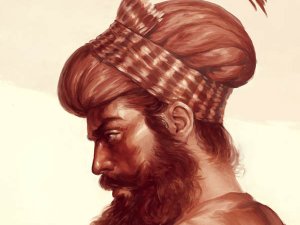Japji is a summary of Guru Nanak’s philosophy of the Nature of God and Universe, the dilemma of life and birth, the way to reach into our inner conscience to cut through the fog of Maya created by our ego so that we can understand the true purpose of life.
Rabindranath Tagore once politely declined a suggestion that he write a universal anthem, stating that it had already been done before by Guru Nanak. Tagore was being humble, but also acknowledging an often-overlooked fact; that Guru Nanak’s sacred words are not only timeless, they are also incredibly beautiful as poetry.
The thirty-eight pauris of the Japji Sahib are a prime example of that, for not only do they uplift the soul, they intoxicate one’s aesthetic senses as well. Vast in scope and breathtaking in imagery, the poem is equal parts descriptive and prescriptive. It maintains a mesmerizing quality about it which leaves a reader both elevated and breathless at its conclusion. In Guru Nanak’s hands, the entire creation comes alive as millions of sentient beings, rivers and mountains, deep oceans and hidden treasure troves vie for space with suns and moons, planets and stars, even other universes. The chaos of the human world is contrasted with the orderliness of the divine order.
In his hands, the immenseness of the universe only heightens man’s own insignificance; man’s helplessness pales before the infinite power of his creator. Yet the poem is not simply a heartless statement of man’s smallness but a key to his eventual salvation; a recipe for an escape from his usual condition. Its goal is to uplift; man may be small and helpless before God but is not without means. God has provided man with ‘jewels within his own mind’ says Guru Nanak, which can be tapped to reach the divine himself.
Using metaphors and similes, allusions and interrogation, Guru Nanak delivers a simple message to all humanity; rituals are useless, all one needs is a humble heart. God is within all sentient beings.
How can man understand the nature of God? The Guru begins by asking rhetorically.
It is by experiencing the divine order — Hukam; and by letting go of one’s ego he himself replies. Hukam, Nanak says, is the reason for all existence. All the creatures, shapes and forms, the heterogeneity of life, the constant cycle of births and deaths is a proof of one universal law that no one may transgress. But, Nanak says, there is a wall of illusion created by our ego and our limited cognizance that makes the One so hard to recognize.
Like dazzling meteors coming unexpectedly in showers, Guru Nanak’s verses keep coming back with more vivid descriptions of the universe. Mountains and oceans, planets and galaxies keep coming back in stanza after stanza. Yet it is not simply a poet’s vanity at display; Guru Nanak has a purpose beyond a display of poetic skill for scattered between these descriptions are his prescriptions for achieving God’s grace. Like a good coach, repetition is a tool Guru Nanak uses deftly to teach, even as he escalates the complexity of training. From a simple injunction to wake up early, in the ambrosial hours, he goes on to advise one to focus on the Naam, from there to become a listener, from listener to a believer; from believer to a chosen one; a ‘Panch’ until finally one is at the ‘Mokh Dawar’ - the doorstep of liberation.
And what door is that? he asks. Where sages and saints, soldiers and maidens; celestial musicians and singers vie for God’s attention and await salvation. Again, more gentle reminders to remain humble; just as water washes away the grime of soiled clothes, prayer and self-reflection washes sins off the souls, he says. Guru Nanak coaxes one to ‘wear’ contentment instead of earrings, humility instead of the begging bowl and meditation instead of the monk’s garb.
Now, the master pauses; and changes tack.
The earth, he says is a Dharam-sal; a workshop, in which souls are expected to perfect themselves, therefore one must pass through four successive Khands (realms) of Dharma, Gyan, Saram and Karma before arriving at the final destination: Sach Khand. It is the abode of God himself and here one is offered a seat in his presence. Once there, all the drama, the imagery and the thunder melts away and serenity prevails.
The poem ends, the way it started; with a Slok (couplet) and yet another dimension emerges. Air, water and land; are teacher, father and the mother respectively, he says. The days and nights are loving nurses that cradle all beings. Guru Nanak has combined the three states of matter with a fourth dimension: time, to describe a space-time continuum. The poet has morphed momentarily into a nature scientist; the universe is the infinite interplay of time and matter.
Together with the opening Slok, which represents the Nirgun (invisible, unseen God within all), this concluding one describing the Sirgun (manifested God – the creation.) Guru Nanak has completed his description of God, the beginning and the conclusion; parts of the one and the same, the everlasting and infinite reality.
The lesson in now complete, and simplicity prevails. To echo Guru Nanak’s own words, ‘Aad, anil, anad anahit jug jug eko vesh’ I salute thee, the Japji Sahib; the primal, the pure and the eternal.




